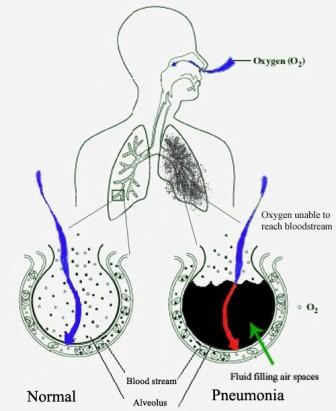Pneumonia history and symptoms
|
Pneumonia Microchapters |
|
Diagnosis |
|---|
|
Treatment |
|
Case Studies |
|
Pneumonia history and symptoms On the Web |
|
American Roentgen Ray Society Images of Pneumonia history and symptoms |
|
Risk calculators and risk factors for Pneumonia history and symptoms |
Editor(s)-in-Chief: C. Michael Gibson, M.S., M.D. [1]; Associate Editor(s)-In-Chief: Priyamvada Singh, M.D. [2]
Overview
People with pneumonia often have a productive cough, fever, chills, shortness of breath, pleuritic chest pain, hemoptysis, headaches, diaphoresis, and clammy skin. Other possible symptoms are loss of appetite, fatigue, cyanosis, nausea, vomiting, mood swings, and joint pains or muscle aches. In elderly people manifestations of pneumonia may not be typical. They may develop a new or worsening confusion or may experience unsteadiness, leading to falls. Infants with pneumonia may have many of the symptoms previously mentioned, but in many cases they are lethargic or have a decreased appetite.
History and Symptoms
 |
Common Symptoms [1][2][3][4]
- Dyspnea
- Productive cough (greenish or yellow sputum)
- Fever (high grade) with sweating, chills, and rigor
- Pleuritic chest pain
- Rapid, shallow breathing
- Shortness of breath
Less Common Symptoms
Elderly
The manifestations of pneumonia might not be typical in older people. They may instead experience:
Infant
Atypical Pneumonia
References
- ↑ Musher, Daniel M.; Thorner, Anna R. (2014). "Community-Acquired Pneumonia". New England Journal of Medicine. 371 (17): 1619–1628. doi:10.1056/NEJMra1312885. ISSN 0028-4793.
- ↑ "WHO Pneumonia Fact Sheets".
- ↑ Mandell, L. A.; Wunderink, R. G.; Anzueto, A.; Bartlett, J. G.; Campbell, G. D.; Dean, N. C.; Dowell, S. F.; File, T. M.; Musher, D. M.; Niederman, M. S.; Torres, A.; Whitney, C. G. (2007). "Infectious Diseases Society of America/American Thoracic Society Consensus Guidelines on the Management of Community-Acquired Pneumonia in Adults". Clinical Infectious Diseases. 44 (Supplement 2): S27–S72. doi:10.1086/511159. ISSN 1058-4838.
- ↑ "National Institute of Allergy and Infectious Diseases - Pneumococcal Pneumonia".